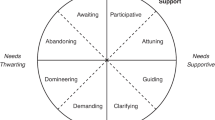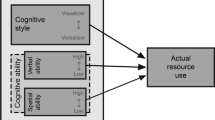Abstract
This paper reports the outcomes of an empirical study undertaken to investigate the effect of students’ cognitive styles on achievement in measurement tasks in a dynamic geometry learning environment, and to explore the ability of dynamic geometry learning in accommodating different cognitive styles and enhancing students’ learning. A total of 49 6th grade students were tested using the VICS and the extended CSA-WA tests (Peterson, Verbal imagery cognitive styles and extended cognitive style analysis-wholistic analytic test—Administration guide. New Zealand: Peterson, 2005) for cognitive styles. The same students were also administered a pre-test and a post-test involving 20 measurement tasks. All students were taught a unit in measurement (area of triangles and parallelograms) with the use of dynamic geometry, after a pre-test. As expected, the dynamic geometry software seems to accommodate different cognitive styles and enhances students’ learning. However, contrary to expectations, verbalisers and wholist/verbalisers gained more in their measurement achievement in the environment of dynamic geometry than students who had a tendency towards other cognitive styles. The results are discussed in terms of the nature of the measurement tasks administered to the students.




Similar content being viewed by others
References
Allport, G. W. (1993). Personality: A psychological interpretation. New York: Holt, Rinehart, and Winston.
Arcavi, A. (2003). The role of visual representations in the learning of mathematics. Educational Studies in Mathematics, 52(3), 215–241.
Armstrong, S. J. (2000). The influence of individual cognitive style on performance in management education. Educational Psychology, 20(3), 323–339.
Atkinson, S. (2004). A comparison of pupil learning and achievement in computer aided learning and traditionally aided taught situations with special reference to cognitive style and gender issues. Educational Psychology, 24, 659–679.
Battista, M. T., & Clements, D. H. (1998). Students’ understanding of three-dimensional cube arrays: Findings from a research and curriculum development project. In R. Lehrer & D. Chazan (Eds.), Designing learning environments for developing understanding of geometry and space (pp. 296–333). Mahwah: Lawrence Erlbaum Associates.
Bishop, A. J. (1989). Review of research on visualisation in mathematics education. Focus on Learning Problems in Mathematics, 11(1), 7–11.
Clements, D. (1982). Visual imagery and school mathematics. For the Learning of Mathematics, 2(3), 33–38.
Clements, D. H., & Battista, M. T. (1992). Geometry and spatial reasoning. In D. Grouws (Ed.), Handbook of research on mathematics teaching and learning (pp. 420–464). New York: NCTM/Macmillan.
Connell, M. (1998). Technology in constructivist mathematics classrooms. Journal of Computers in Mathematics and Science Teaching, 17(4), 311–338.
Cuoco, A., & Goldenberg, E. P. (1996). A role for technology in mathematics education. Journal of Education, 178(2), 15–32.
Davis, B., & Simmt, E. (2003). Understanding learning systems: Mathematics education and complexity science. Journal for Research in Mathematics Education, 34(2), 137–167.
Dreyfus, T. (1991). On the status of visual reasoning in mathematics and mathematics education. In F. Furinghetti (Ed.), Proceedings of the 15th International Conference for the Psychology of Mathematics Education, vol. 1 (pp. 33–48). Assisi, Italy.
Dunn, R., Beaudry, J. S., & Klavas, A. (1989). Survey of research on learning styles. Educational Leadership, 46(6), 50–58.
Eisenberg, T., & Dreyfus, T. (1991). On the reluctance to visualize in mathematics. In W. Zimmermann & S. Cunningham (Eds.), Visualisation in teaching and learning mathematics (pp. 26–37). Washington DC: MAA.
Ekstrom, R. B., French, J. W., & Harman, H. H. (1976). Manual for kit of factor referenced cognitive tests. Princetown, NJ: Educational Testing Service.
Ellis, R. D., & Kurniawan, S. H. (2000). Increasing the usability of online information for older users: A case study in participatory design. International Journal of Human–Computer Interaction, 12(2), 263–276.
Ford, N. (1999). Learning styles for adaptive course delivery: Problems and prospects. In J. Hill, S. Armstrong, M. Graff, S. Rayner, & E. Sadler-Smith (Eds.), Proceedings for the Annual Conference of the European Learning Styles Information Network (pp. 187–202). Preston: University of Central Lancashire.
Friend, C. L., & Cole, C. L. (1990). Learner control in computer-based instruction: A current literature review. Educational Technology, 30(11), 47–49.
Graff, M. G. (1999). Cognitive style and hypertext structures. In J. Hill (Ed.), Proceedings of the 4th European Learning Styles Conference (pp. 233–242). Preston: University of Central Lancashire.
Gutiérrez, A. (1996). Visualization in 3-dimensional geometry. In search of a framework. In L. Puig & A. Gutiérrez (Eds.), Proceedings for the 20th Conference for the Psychology of Mathematics Education vol. 1, (pp. 3–19). Valencia, Spain: University of Valencia.
Hunt, J. D. (1994). Evaluating core values regarding transportation and urban form in Calgary. Calgary, Canada: Calgary GoPlan Project.
John, D., & Boucouvalas, A. (2002). User performance with audio: The effect of subjects’ cognitive styles. Educational Psychology, 22(2), 133–147.
Johnston-Wilder, S., & Mason, J. (2005). Developing thinking in geometry. London: Sage.
Kagan, J. (1965). Individual difference in the resolution of response uncertainty. Journal of Personality and Social Psychology, 2, 154–160.
Kosslyn, S. M. (1980). Image and mind. Cambridge, MA: Harvard University Press.
Kozhevnikov, M. (2007). Cognitive styles in the context of modern psychology: Toward an integrated framework of cognitive style. Psychological Bulletin, 133, 464–481.
Laborde, C., Kynigos, C., Hollebrands, K., & Strässer, R. (2006). Teaching and learning geometry with technology. In A. Gutiérrez & P. Boero (Eds.), Handbook of research on the psychology of mathematics education. Past, present and future (pp. 275–304). Rotterdam, The Netherlands: Sense.
Logismos Inc. (2002). Euclidraw Jr, Retrieved March, 2007 from http://www.euclidraw.com/.
Murphy, K. R., & Davidshofer, C. O. (2001). Psychological testing: principles and application (5th ed.). Upper Saddle River, New Jersey: Prentice-Hall.
Outhred, L., & Mitchelmore, M. (2000). Young children’s intuitive understanding of rectangular area measurement. Journal for Research in Mathematics Education, 31(2), 144–167.
Paivio, A. (1971). Imagery and verbal processes. New York: Rinehart and Winston, Holt.
Parkinson, A., & Redmond, J. A. (2002). Do cognitive styles affect learning performance in different computer media. Proceedings of the 7th annual conference on innovation and technology in computer science education, association for computing machinery (pp. 39–43). New York: ACM.
Pask, G. (1972). A fresh look at cognition and the individual. International Journal of Man–Machine Studies, 4, 211–216.
Peterson, E. R. (2005). Verbal imagery cognitive styles and extended cognitive style analysis-wholistic analytic test—Administration guide. New Zealand: Peterson.
Peterson, E. R., Austin, E. J., & Deary, I. J. (2005). A new measure of verbal–imagery cognitive style. Personality and Individual Differences, 38, 1269–1281.
Peterson, E. R., Deary, I. J., & Austin, E. J. (2003). The reliability of the cognitive styles analysis test. Personality and Individual Differences, 34, 881–891.
Presmeg, N. C. (1986). Visualisation and mathematical giftedness. Educational Studies in Mathematics, 17, 297–311.
Presmeg, N. C. (1997). Generalization using imagery in mathematics. In L. D. English (Ed.), Mathematical reasoning: Analogies, metaphors and images (pp. 299–312). Mahwah, New Jersey: Lawrence Erlbaum Associates.
Presmeg, N. C. (2001). Visualisation and affect in non-routine problem solving. Mathematical Thinking and Learning, 3, 289–313.
Presmeg, N. C. (2006). Research on visualization in learning and teaching mathematics: Emergence from psychology. In A. Gutiérrez, & P. Boero (Eds.), Handbook of research on the psychology of mathematics education. Past, present and future (pp. 205–236). Rotterdam, The Netherlands: Sense.
Pyke, C. L. (2003). The use of symbols, words, and diagrams as indicators of mathematical cognition: A causal model. Journal for Research in Mathematics Education, 34(5), 406–432.
Riding, R. J., & Cheema, I. (1991). Cognitive styles: An overview and integration. Educational Psychology, 11, 193–215.
Riding, R. J., & Douglas, G. (1993). The effect of cognitive style and mode of presentation on learning performance. The British Journal of Educational Psychology, 63, 297–307.
Riding, R. J., & Grimley, M. (1999). Cognitive style and learning from multimedia CD-ROMs in 11-year-old children. British Journal of Educational Technology, 30, 43–56.
Riding, R. J., & Rayner, S. (1998). Cognitive styles and learning strategies: Understanding style differences in learning and behaviour. London: D. Fulton.
Riding, R. J., & Sadler-Smith, E. S. (1992). Type of instructional material, cognitive style and learning performance. Educational Studies, 18(3), 323–340.
Riding, R. J., & Watts, M. (1997). The effect of cognitive style on the preferred format of instructional material. Educational Psychology, 17, 179–183.
Schroeder, T. L., & Lester, F. K., Jr. (1989). Developing understanding in mathematics via problem solving. In P. R. Trafton (Ed.), New directions for elementary school mathematics (pp. 31–42). Reston VA: National Council of Teachers of Mathematics.
Sternberg, R. J. (1990). Intellectual styles: Theory and classroom applications. In R. McClure (Ed.), Learning and thinking styles: Classroom interaction (pp. 18–42). Washington: National Education Association.
Sternberg, R. J., & Grigorenko, E. L. (1997). Are cognitive styles still in style. The American Psychologist, 52(7), 700–712.
Stylianou, D. (2001). On the reluctance to visualize in mathematics: Is the picture changing. In M. van den Heuvel-Panhuizen (Ed.), Proceedings of the 25th International Conference for the Psychology of Mathematics Education vol. 4, (pp. 225–232). The Netherlands: Utrecht University.
Tartre, L. A. (1990). Spatial skill, gender, and mathematics. In E. Fennema & G. Leder (Eds.), Mathematics and gender: Influences on teachers and students (pp. 27–59). New York: Teachers College Press.
Witkin, H. A. (1962). Psychological differentiation: Studies of development. New York: Wiley.
Woolner, P. (2004). A comparison of a visual–spatial approach and a verbal approach to teaching mathematics. In M. J. Høines, & A. B. Fuglestad (Eds.), Proceedings of the 28th International Group for the Psychology of Mathematics Education vol. 4, (pp. 449–456). Norway: Bergen University College.
Yakimanskaya, I. S. (1999). The development of spatial thinking in schoolchildren. In P. S. Wilson & E. J. Davis (Eds.), Soviet studies in mathematics education (vol. 4). Reston VA: National Council of Teachers of Mathematics.
Author information
Authors and Affiliations
Corresponding author
Rights and permissions
About this article
Cite this article
Pitta-Pantazi, D., Christou, C. Cognitive styles, dynamic geometry and measurement performance. Educ Stud Math 70, 5–26 (2009). https://doi.org/10.1007/s10649-008-9139-z
Received:
Accepted:
Published:
Issue Date:
DOI: https://doi.org/10.1007/s10649-008-9139-z




